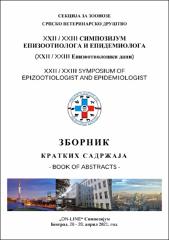| dc.contributor.author | Petrović, Tamaš | |
| dc.contributor.author | Lupulović, Diana | |
| dc.contributor.author | Paunović, Milan | |
| dc.contributor.author | Vidanović, Dejan | |
| dc.contributor.author | Lazić, Gospava | |
| dc.contributor.author | Samojlović, Milena | |
| dc.contributor.author | Lazić, Sava | |
| dc.date.accessioned | 2021-06-24T07:25:40Z | |
| dc.date.available | 2021-06-24T07:25:40Z | |
| dc.date.issued | 2021-04-26 | |
| dc.identifier.isbn | 978-86-83115-41-9 | |
| dc.identifier.uri | https://repo.niv.ns.ac.rs/xmlui/handle/123456789/370 | |
| dc.description.abstract | Several species of bats are known as a reservoir of a large number of emergent and highly pathogenic viruses, among which, in addition to hemorrhagic fever viruses (Ebola and Marburg) and paramyxoviruses (Nipah and Hendra), coronaviruses certainly occupy a significant place. Only during the last 20 years of the 21st century, 3 significant epidemics / pandemics with a severe clinical picture were recorded: coronavirus of severe acute respiratory syndrome (SARS-CoV), Respiratory coronavirus syndrome of the Middle East (MERS-CoV), and the current pandemic of coronavirus disease 2019 ( COVID-19) caused by the coronavirus of severe acute respiratory syndrome 2 (SARS-CoV-2).
Recent research on the presence of coronavirus in bats began during 2016/2017. The feces sample of 142 individuals from 12 localities in Serbia were collected. During 2020, fecal samples from another 40 bats were collected from 2 localities. The analysis were performed by the conventional RT-PCR method according to the protocol of Rihtaric et al. from 2010. The presence of coronavirus was detected in 24.65% (35/142) of the tested samples from 2016 and 2017 and in 7 of the 12 tested localities, as well as in 27.50% (11/40) of the tested samples from 2020 on both tested localities. Overall, the presence of coronavirus was found in 8 of the 15 bat species analysed (Myotis nattereri, Myotis capaccinii, Myotis myotis, Myotis blythii, Rhinolophus ferrumequinum, Rhinolophus euryale, Miniopterus schreibersii and Rhinolophus hipposideros). The detected viruses were molecularly typed as virus strains belong to alpha, beta and unclassified bat coronaviruses similar to those detected in Bulgaria, Italy, Hungary, Spain and others. This research is still ongoing.
It can be concluded that the presence of coronavirus was found in the populations of a large number of bat species (8) in Serbia and in an average of 25% of the population, and that the detected viruses belong to alpha, beta and unclassified bat coronaviruses similar to those found in neighbouring countries. Although it is known that bats can serve as a potential source of viral pathogens, none of the species of bats identified so far in Serbia have been linked to the development of the disease in humans in Serbia. The obtained research results, as well as the current pandemic situation caused by the SARS-CoV-2 virus, indicate the need for much more intensive and coordinated surveillance of zoonotic potential viruses in bats in Serbia and the region based entirely on the postulates of "One Health". | en_US |
| dc.description.sponsorship | This work was funded by Ministry of Education, Science and Technological Development of Serbia by the Contract of implementation and financing of research work in NIV-NS, Contract No: 451-03-9/2021-14/200031, and by project “Monitoring of bat roosts and populations in Serbia”, co-funded by the Ministry of Environmental Protection of Serbia and Natural History Museum in Belgrade | en_US |
| dc.language.iso | other | en_US |
| dc.publisher | SVD, Sekcija za zoonoze, Beograd (Srbija) | en_US |
| dc.source | Zbornik kratkih sadržaja, XXII/XXIII Simpozijum epizootiologa i epidemiologa (XXII/XXIII Epizootiološki dani), on-line, Beograd | sr |
| dc.subject | coronaviruses | en_US |
| dc.subject | bats | en_US |
| dc.subject | Serbia | en_US |
| dc.title | Detekcija i tipizacija koronavirusa kod slepih miševa u Srbiji | en_US |
| dc.title.alternative | Detection and typing of coronaviruses in bats in Serbia | en_US |
| dc.title.alternative | | en_US |
| dc.type | Article | en_US |

